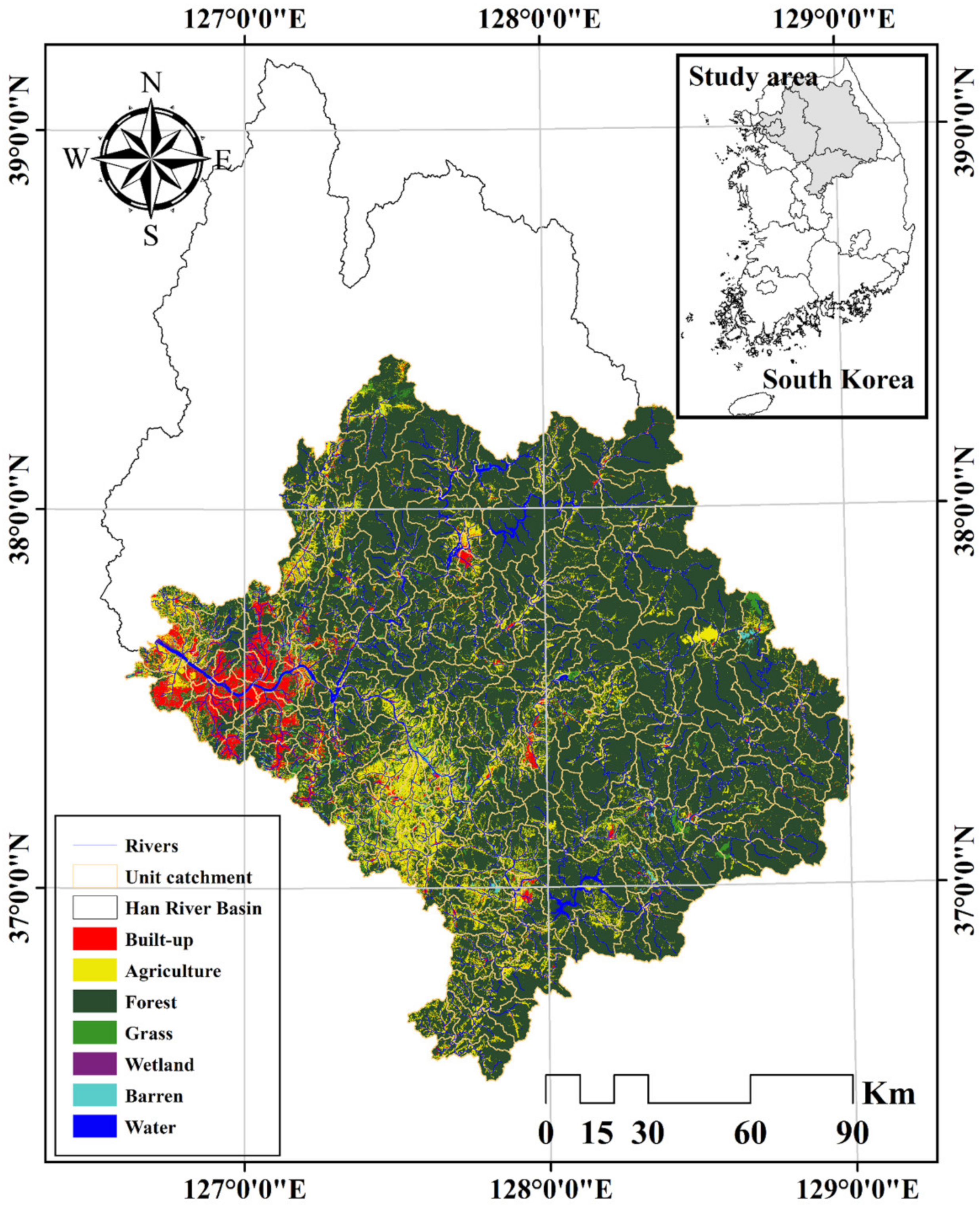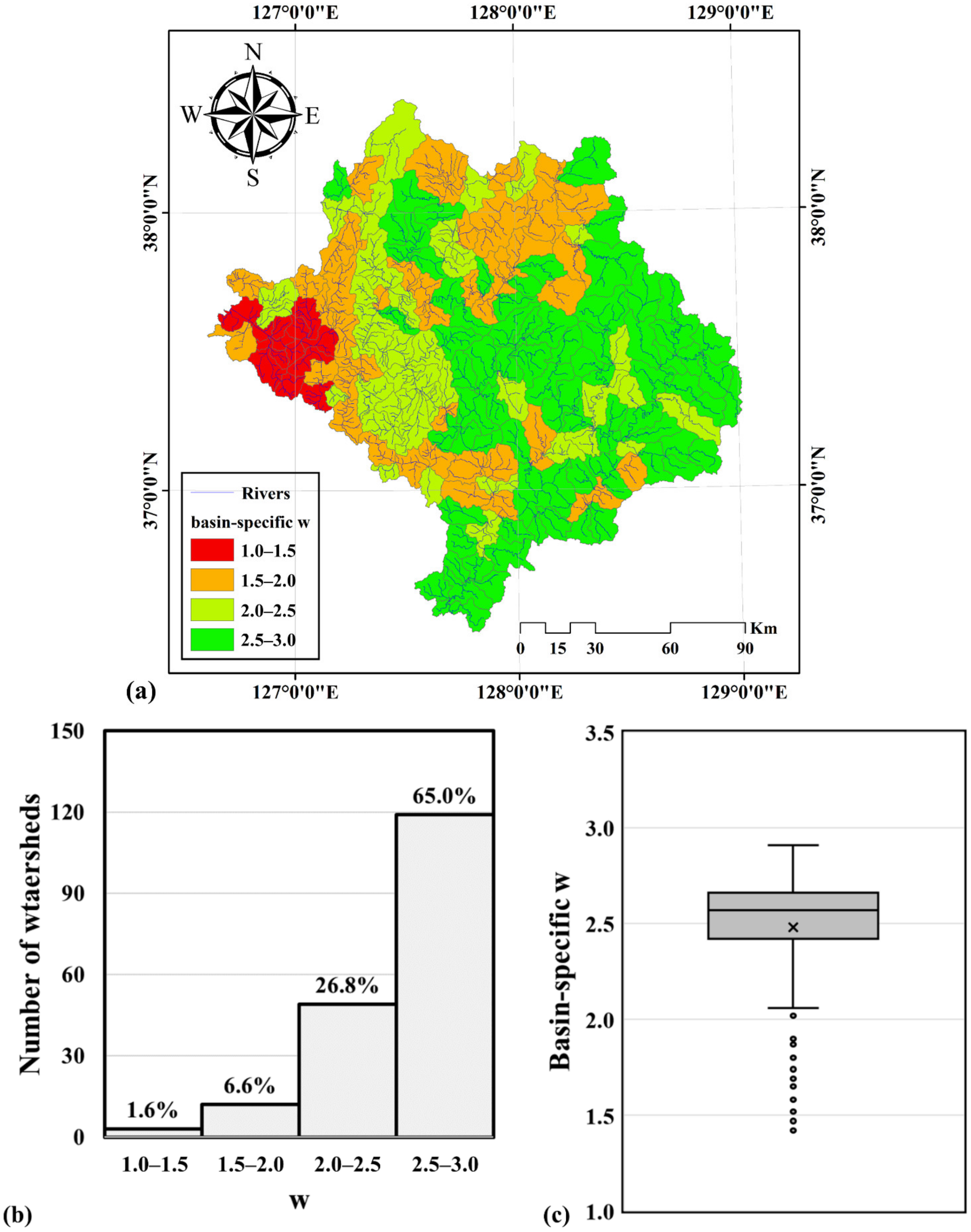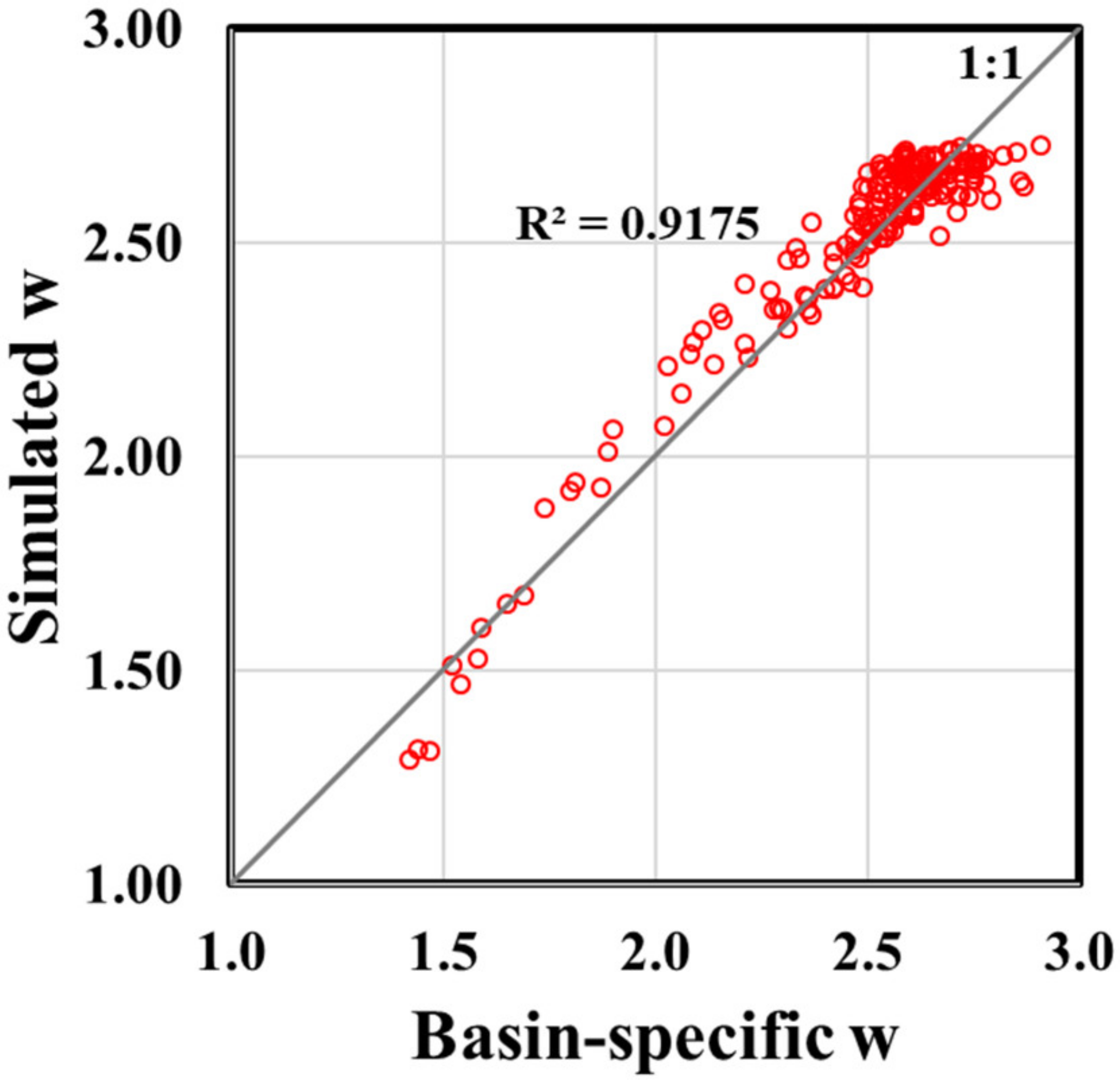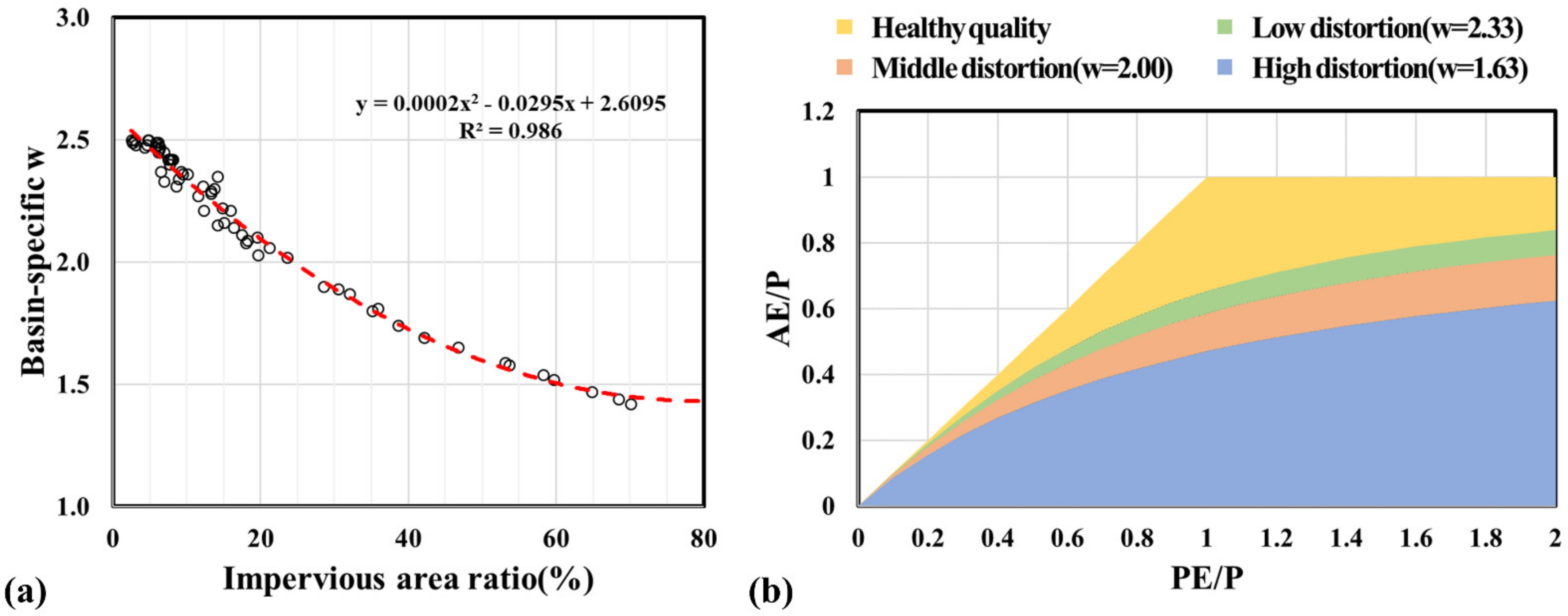1. Introduction
The global hydrological system has constantly been changing due to climate change and land-use changes that result from various human activities [
1,
2,
3,
4,
5,
6,
7]. For sustainable development, understanding changes in the hydrological systems is essential for policymakers, and various hydrological and ecological indicators that have been determined scientifically have facilitated the understanding of such changes [
8,
9,
10,
11,
12,
13]. Hydrological indicators have been developed and utilized to explore the magnitude, frequency, duration, timing, and rate of change of flow events. Olden and Poff [
8] analyzed such indicators using principal component analysis and reduced the Indicators of Hydrologic Alteration (IHAs) to 33. Since then, IHAs have been used to identify hydrological changes in various countries and watersheds [
9,
10,
11,
12,
13]. Black et al. [
9] classified such indicators into five grades (without impact, low risk of impact, moderate risk of impact, high risk of impact, and severe impact) and evaluated the degree of hydrological change they generated. Although the IHAs can be used to identify changes in the hydrological systems, their capacity to identify and quantify the causes of such changes, which are influenced by various factors, is limited. To develop effective policies for the recovery of degraded hydrological systems, it is necessary to derive a novel indicator capable of identifying the causes of the changes in the hydrological systems under study.
Climate change is one of the key factors influencing change in hydrological systems. Climate is changing due to both natural factors and human activities (such as increased carbon dioxide emissions), which further influence evaporation, precipitation, and snowfall [
6], and in turn, change in the global hydrological system. Consequently, conventional hydrological indicators exhibit large variations due to climate change. In other words, it is not easy to evaluate the effectiveness of watershed management every year using existing indicators.
To achieve effective watershed management, research is being conducted to identify and isolate hydrological system changes based on their causes (e.g., human activities such as climate change and land-use change) [
14]. To this end, climate elasticity modeling- (mainly Budyko) and hydrological modeling-based approaches have been applied.
The hydrological modeling-based approach is to analyze changes using hydrological models such as the Soil and Water Assessment Tool (SWAT), Hydrological Simulation Program-Fortran (HSPF), Geomorphology-Based Hydrological Model (GBHM), and simplified version of the HYDROLOG (SIMHYD). In the hydrological modeling-based approach, simulation results are compared and analyzed at the baseline, which means before the change, with the target line, which means the target time point. The result of the target line is simulated by applying scenarios such as climate change and land-use change to the corrected model, followed by a comparison with the baseline result. Each scenario is quantified using indicators such as annual runoff. In addition, since the hydrological model can simulate a scenario in which the change factor is limited, it can easily evaluate the impact of each change. It can also be applied to watersheds where there is no long-term data monitoring, and future forecasting using climate change scenarios is also possible. However, the selection of an appropriate baseline is challenging. The correction process of the hydrological model for each watershed is extremely time-consuming.
The climate elasticity model mainly uses the Budyko curve, which is a curve derived based on the Budyko hypothesis. At the watershed scale, the long-term water-energy balance is used to partition precipitation (P, mm) into actual evapotranspiration (AE, mm) and runoff if water storage change is ignored [
14,
15]. Budyko [
16] proposed the relationship between the ratio of the actual evaporation amount to the annual precipitation (AE/P, called the evaporative index) and the ratio of the potential evaporation (PE, mm) amount to the annual precipitation (PE/P, called the dryness index or aridity index) based on data obtained from numerous watersheds [
5]. The Budyko curve is different for each watershed, and the point on the curve moves due to climate change. Therefore, it is possible to predict when climate changes. It has the advantage of quantitatively evaluating the effect of improving the hydrological system by watershed management. Fu [
17] and Choudhury [
18] developed a single parameter (w)-based Budyko equation by supplementing the initial Budyko curve, which is given as follows:
where P is the annual precipitation, AE is the actual evapotranspiration, PE is the potential evapotranspiration, and w is the single parameter of the Budyko curve. The parameter is reported to be related to land surface characteristics and soil types [
19,
20,
21,
22,
23,
24].
It is important for watershed managers to use indicators to understand the status and changes of hydrology in the watershed. However, it was difficult to determine whether the impact of the change was due to watershed management or climate change, as the indicators in the past were largely influenced by influences such as precipitation. In a watershed, Budyko parameter w is only constant when climate change exists and tends to vary when there are changes in land use, vegetation, and soil type. In other words, the change in w can express watershed development and recovery. Furthermore, since the w of the Budyko curve can be evaluated based on the monitored data, it can effectively evaluate change in watersheds annually.
The main purpose of this study was to introduce the parameter (w) of the Budyko curve as an indicator for evaluating watershed quality that is not influenced by climate change. The developed indicator is applied for each watershed to derive the current watershed quality value, which is graded according to cluster analysis and previous studies. The developed indicator is evaluated as a watershed evaluation indicator through the verification of w changes in the course of watershed management practice.
2. Materials and Methods
In the present study, we introduce the Budyko framework parameter as a watershed hydrological system management index and develop the criteria for evaluating the water cycle quality of the watershed. The procedure applied in the present study is as follows:
- (1)
Securing insufficient historical data for each basin using a hydrological model,
- (2)
Estimation of unique w for watersheds using historical data (basin-specific w),
- (3)
Development of a regression model for estimating the w of an uncalibrated watershed,
- (4)
Development of evaluation criteria for a hydrological system,
- (5)
Evaluation of applicability of evaluation criteria using a hydrological model,
2.1. Study Area
The Han River basin in Korea, which consists of 24 sub-basins and 237 unit catchments (
Figure 1), was selected as the study area. Among the 24 sub-basins, 7 sub-basins and 54 unit catchments are located in North Korea, making it difficult to obtain data; therefore, only 183 unit catchments were used for analysis. Within the basin, there are 48 flow measurement points of the Ministry of Environment (MOE) in Korea and 27 meteorological stations of the Meteorological Administration. The flow measurement data for 2011–2015 were collected and used to calibrate the hydrological model. Meteorological observation data were collected for 1970–2015 and were used for hydrological modeling, and potential evapotranspiration and aridity index calculation, etc.
Table 1 presents a summary of characteristics in the 183 unit catchments. Potential evapotranspiration was calculated using the FAO-56 Penman–Monteith equation. The range of aridity index was 0.2–1.8, with an average of 0.7. The climate of the study site, which was classified according to the criteria in a previous study [
25], was humid or semi-humid. The watershed area was 39.2–449.75 km
2, which was smaller than those in previous studies [
22,
23,
24]. For the land use, the data from the MOE created in 2013 were used. The unit catchment located in the upper reaches of the Han River basin has a high proportion of forests, while that located downstream is urbanized. In the Han River basin middle stream, several unit catchments with a high proportion of agricultural areas are distributed. As such, the Han River basin is suitable for analyzing various land-use type watersheds.
2.2. HSPF Simulation for Data Source of Basin-Specific Budyko Parameters
To derive basin-specific Budyko parameters, calculating AE/P from long-term runoff or actual evaporation data according to weather conditions is necessary in the same watershed environment. However, flow rate observation points are not located within all unit catchments in the study site. Moreover, AE is challenging to predict due to vegetation change; due to the heterogeneity of the basin environment, such as land use and vegetation change, the value of w of the Budyko parameter changes annually. In the present study, HSPF was used to make up for insufficient data and derive highly accurate basin-specific w values for the current status of the basin.
HSPF is a process-based, conceptual, and continuous simulation watershed model for quantifying hydrology and water quality. It can simulate runoff and pollutant loadings for watersheds and perform flow and water quality routing in the watershed reaches [
26,
27]. HSPF uses time-series data such as rainfall, temperature, and solar radiation as well as land-use data such as land-use patterns and land management practices [
28]. HSPF has three modules: pervious land segment, impervious land segment, and free-flowing reach [
26,
27]. HSPF computes hydrological cycle components (evapotranspiration, surface detention, surface runoff, infiltration, interflow, base flow, and percolation to deep groundwater) in the pervious land segment. It only computes surface components of the hydrological cycle in the impervious land segment, while in the free-flowing reach, HSPF computes hydraulic behavior using kinematic assumption.
Sub-watershed, topographic, and hydrological data were constructed for use in the simulation of HSPF (
Figure 1). A sub-watershed is a unit catchment that has been partially divided for calibration. Topographic data are used for the digital elevation model (DEM) and land-use map, following the conversion of altitude img files provided by the National Geographic Information Institute (NGII) into a grid (10 m × 10 m). Land use was constructed with data provided by the MOE as of 2013 and classified into seven land-use types (
Table 2). Weather data were constructed as hydrological data from 1970 to 2015 observed at the automated surface observing systems (ASOS) site, such as precipitation, average temperature, and insolation. Moreover, to reflect the artificial flow, dams, beams, and sewage treatment plant discharge data from 2010 to 2014 were used.
The model was calibrated and validated using the trial and error method for 48 points, and observed data were acquired using the water resources management information system (WAMIS). Calibration of the model was performed for 2010–2012, and validation was done for 2013–2014. For the evaluation of the calibrated results, the criteria proposed by [
29] were applied, which are shown in
Table 3.
2.3. w Estimated Model Development and Watershed Quality Criteria Established
The Budyko parameter for each watershed (basin-specific w) was corrected to minimize the root mean square error (RMSE) of Budyko-simulated and model-simulated AE/P values on the annual scale. The AE of the model-simulated AE/P was derived as AE = P − Q by assuming P = Q + AE according to the long-term water-energy balance at the basin scale. Data from 1970 to 2015 were used, and basin-specific w of 183 watersheds was derived.
The w estimation model was developed using stepwise multiple regression analysis to evaluate change in w due to changes in the watershed environment. As an independent variable for estimating w, the area ratios of the seven land-use classifications in
Table 2 were used, and data from 183 watersheds were used for the multiple regression analysis.
Correlation and cluster analyses were used to develop watershed quality evaluation criteria using w. Pearson correlation analysis was performed to extract factors with a high correlation with w, and factors with high correlation were used for cluster analysis. Cluster analysis was used to create classes for classifying watershed quality. An appropriate number of clusters was derived from a dendrogram, and K-means cluster analysis was performed according to the number.
2.4. HSPF LID Tool for Watershed Quality Criteria Applicability Assessment
The applicability of watershed quality criteria was analyzed using HSPF applied to the watershed management technique. HSPF’s low impact development (LID) Tool was used, and the Gulpocheon unit catchment with a large change in w in 2013 compared to that in 1975 was selected as the study area. The LID was applied to the calibrated HSPF, and the runoff was calculated. The LID tool has been used in many studies, and a detailed explanation is described in the study of Mohamoud et al. [
30].
4. Conclusions
In the present study, we used the Budyko curve parameters as watershed management indices and attempted to establish watershed quality grades. Fu’s equations for the Budyko curve and a single parameter, w, were used, and basin-specific w was calculated for 183 sub-basins. A w estimation model was developed by multiple regression analysis of land-use data and basin-specific w. Cluster analysis was used to establish watershed quality standards, in addition to a dendrogram and an ICM. Finally, the indicator’s applicability was evaluated by applying the watershed management technique to the hydrological model HSPF.
The results of the present study showed that the parameter w of the Budyko curve parameter could facilitate the evaluation of watershed quality. w showed a high correlation with the percentage of land-use area in the watershed, especially with built-up area and forestland uses. Cluster analysis was performed on w with the impervious area ratio, which is related to the built-up area and has been extensively used as a watershed management indicator. Based on the dendrogram and ICM, w was classified into four grades, and changes in watershed quality in the past and present were analyzed. With urbanization, the built-up area ratio increased compared to that of the past, and the watershed quality deteriorated in 31 watersheds. In addition, watershed quality criteria changed with w, which was calculated as a result of the simulation of LID application as a watershed management technique in HSPF. At the same time, we confirmed that w can be used as an indicator for the evaluation of watershed quality in watersheds where the LID technique, which is an example of sustainable development, is applied.
In conclusion, the indicator w developed in the present study can be easily utilized by policymakers for watershed quality assessment and hydrological system identification. Since the watershed quality can be evaluated by the ratio of land-use area, it will be possible to assess the quality in the past and present easily and can be used to predict changes in watershed quality according to the watershed development plans. In addition, since it is possible to evaluate it in connection with hydrological modeling through the application of watershed management techniques, it will be possible to identify changes in watershed quality, including development plans and watershed management plans, and use them to establish optimal strategies for quality improvement. The developed indicator is judged to be a valuable result in that it is possible to easily evaluate only the results of watershed management regardless of the various climates of the hydrology system, which is highly affected by rainfall.
Nevertheless, the indicator in the present study has two limitations. First, in some watersheds, the point on the Budyko curve cannot be determined using the observed stream discharge. Some watersheds have reservoirs and sewage treatment plants, and the flow of streams changes due to the discharge from such facilities. Because the Budyko hypothesis explains natural water-energy balance, the developed indicator did not consider the effect of artificial discharge. Therefore, the current watershed quality cannot be evaluated using the monitored discharge. If the reservoir’s effect is also considered with the model used in other studies [
34,
35], and the other artificial flow is considered, the indicator is expected to improve. Secondly, complex hydrological modeling was included for evaluation including watershed management plans. If additional elements such as the subdivision of land-use types and the application of LID management areas are supplemented in the indicator estimation model through further research, it would be more effectively used to assess watershed quality.














